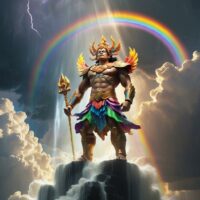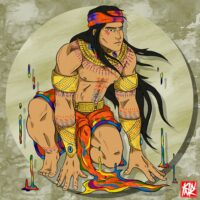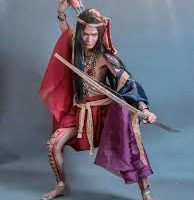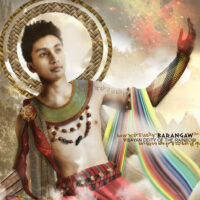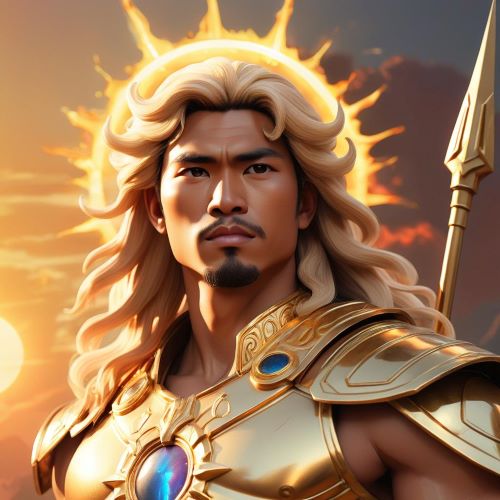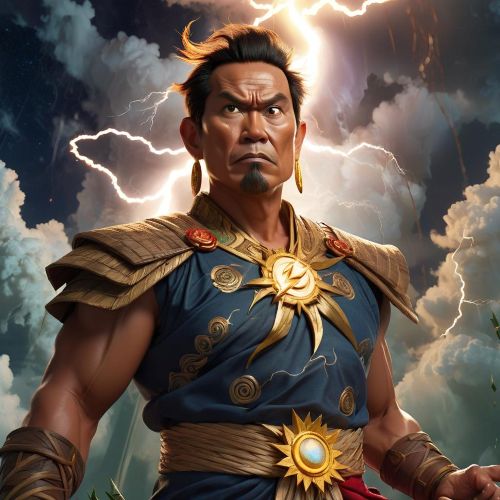Barangaw : God of the Rainbow
Listen
At a glance
| Description | |
|---|---|
| Origin | Philippine Mythology |
| Classification | Gods |
| Family Members | N/A |
| Region | Philippines |
| Associated With | Rainbows, Hope |
Barangaw
Introduction
Banrangaw is a revered deity in ancient Visayan mythology, celebrated as the god of the rainbow and a symbol of divine guidance and hope. While the rainbow is often seen as a natural marvel, in the cultural context of the Visayas, its appearance held far deeper meaning. Banrangaw was considered a celestial being who marked his presence through this radiant arc in the sky. His role was pivotal during moments of war and transition, where he served as a harbinger of success and a bridge between the human and divine. Unlike more prominent deities in Philippine mythology, Banrangaw holds a unique space as both a visual and spiritual emblem of protection, valor, and transcendence.
Physical Traits
Rather than being described in a conventional human form, Banrangaw is more often associated with the physical manifestation of the rainbow itself. The colors stretching across the sky are considered his divine expression. However, in oral traditions, some portray him as a powerful, radiant warrior draped in armor that glimmers in the full spectrum of the rainbow. His ethereal presence embodies both strength and beauty, his eyes imagined to shine like twin stars, and his voice echoing like the thunder that often precedes his arrival. These interpretations elevate Banrangaw beyond a simple god of weather, rendering him a celestial force capable of shaping the destinies of both mortals and spirits.
Family
Banrangaw does not belong to a well-documented divine family within the pantheon of Philippine mythology, setting him apart from other deities who are often described in the context of familial lineages. His mythological associations are more functional than genealogical, rooted in his role among the triad of Visayan war gods. Alongside Ynaguinid and Makanduk, Banrangaw formed a trinity of divine forces that were invoked before battle. While not explicitly connected by blood, these deities were united by purpose, working in spiritual kinship to support warriors and guide souls. This form of mythological brotherhood emphasizes collective duty over familial hierarchy, highlighting Banrangaw’s role as a protector and guide.
Other names
In different regions and through varying oral and colonial transcriptions, Banrangaw is also referred to as Balangaw, Barangaw, and even Makaobus in some older accounts. These variations reflect the shifting nature of oral storytelling and the influence of local dialects across the Visayas. The name Makaobus, translating loosely to “without having,” hints at a spiritual humility or detachment, a quality that aligns with Banrangaw’s role as a mediator between heaven and earth. While these names differ in sound and form, they consistently point to the same celestial figure who commands the colors of the sky and guides the spirits of the brave.
Powers and Abilities
Banrangaw’s abilities stretch far beyond the simple manipulation of light and water to form a rainbow. He is known as a transporter of souls, offering a celestial bridge for fallen warriors to ascend to the afterlife. His rainbow is seen as both a divine vehicle and a sign of approval from the gods. When warriors spotted a rainbow before or after a battle, it was interpreted as Banrangaw’s presence and a prophecy of success. This belief spurred rituals and sacrifices to honor him, with hopes of gaining his favor in war. Additionally, he had the power to maintain harmony between storm and sunlight, influencing weather patterns in symbolic ways. His appearance in the sky signaled a divine intervention—whether as a message, a blessing, or a farewell to the departed.
Modern Day Influence
Though Banrangaw may not hold a prominent place in the popular media landscape of modern Philippines, his symbolic presence is far from forgotten. In many Visayan communities, the rainbow continues to carry a sacred connotation. It is seen as a sign of peace, renewal, and protection—qualities intrinsically tied to Banrangaw’s legacy. Local festivals often treat the rainbow as a celebratory symbol, and traditional songs and dances still echo themes of celestial guardianship and spiritual travel. In the arts, Banrangaw has inspired contemporary poets, illustrators, and cultural scholars who are reintroducing ancient deities to younger generations. His image occasionally appears in murals, folk-inspired literature, and educational platforms that aim to preserve indigenous heritage. Among modern spiritual practitioners, particularly Babaylans and cultural healers, Banrangaw is still evoked in rituals that seek guidance, healing, or connection with the ancestors. His identity has also found relevance in diaspora communities, where the rainbow symbolizes resilience, migration, and spiritual continuity.
In digital spaces, blogs and social media posts have sparked renewed curiosity about native deities like Banrangaw. Comparisons to similar mythological figures—such as the Norse Bifröst or the Greek goddess Iris—have placed Banrangaw in a global context, enriching discussions about shared human fascination with celestial pathways. As Filipinos increasingly seek to reconnect with pre-colonial roots, Banrangaw emerges not just as a war god or weather symbol, but as a cultural anchor for identity, faith, and artistic expression.
In this ongoing journey to reclaim indigenous narratives, Banrangaw’s enduring arc across the sky remains a vivid emblem of hope—linking the past to the present, and earth to the heavens.
Related Images
Source
Clark, J. (2018, April 20). Rainbows in Philippine Mythology & Folklore. The Aswang Project. https://www.aswangproject.com/rainbows-in-philippine-mythology-folklore/
Puerto Parrot. (2018, January 29). Visayan War Gods / Philippine Mythology. https://www.puertoparrot.com/articles/visayan-war-gods-philippine-mythology
Sanchez, M. (1711). Vocabulario de la lengua Bisaya.
Scott, W. H. (1994). Barangay: Sixteenth-century Philippine Culture and Society. Ateneo de Manila University Press.
Vizayan Myths. (2013, May). Barangaw. https://vizayanmyths.blogspot.com/2013/05/barangaw.html
Porio, E., & Roque-Sarmiento, E. (2019). Barangay. In A. Orum (Ed.), Wiley Blackwell Encyclopedia of Urban and Regional Studies. Wiley.
Frequently Asked Questions
What is lorem Ipsum?
I am text block. Click edit button to change this text. Lorem ipsum dolor sit amet, consectetur adipiscing elit. Ut elit tellus, luctus nec ullamcorper mattis, pulvinar dapibus leo.
What is lorem Ipsum?
I am text block. Click edit button to change this text. Lorem ipsum dolor sit amet, consectetur adipiscing elit. Ut elit tellus, luctus nec ullamcorper mattis, pulvinar dapibus leo.
What is lorem Ipsum?
I am text block. Click edit button to change this text. Lorem ipsum dolor sit amet, consectetur adipiscing elit. Ut elit tellus, luctus nec ullamcorper mattis, pulvinar dapibus leo.
What is lorem Ipsum?
I am text block. Click edit button to change this text. Lorem ipsum dolor sit amet, consectetur adipiscing elit. Ut elit tellus, luctus nec ullamcorper mattis, pulvinar dapibus leo.
What is lorem Ipsum?
I am text block. Click edit button to change this text. Lorem ipsum dolor sit amet, consectetur adipiscing elit. Ut elit tellus, luctus nec ullamcorper mattis, pulvinar dapibus leo.


